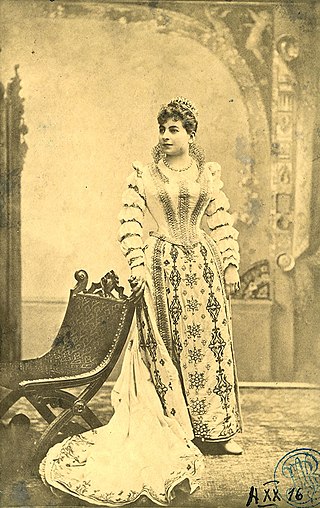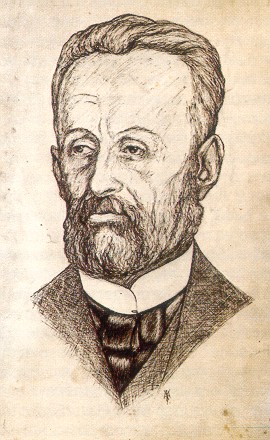
Un ballo in maschera is an 1859 opera in three acts by Giuseppe Verdi. The text, by Antonio Somma, was based on Eugène Scribe's libretto for Daniel Auber's 1833 five act opera, Gustave III, ou Le bal masqué.

Luisa Miller is an opera in three acts by Giuseppe Verdi to an Italian libretto by Salvadore Cammarano, based on the play Kabale und Liebe by the German dramatist Friedrich von Schiller.

Hariclea Darclée was a celebrated Romanian operatic spinto soprano who had a three-decade-long career.

Pavlos Carrer was a Greek composer, one of the leaders of the Ionian art music school and the first to create national operas and national songs on Greek plots, Greek librettos and verses, as well as melodies inspired by the folk and the urban popular musical tradition of modern Greece.

Francesco (Franco) Antonio Faccio was an Italian composer and conductor. Born in Verona, he studied music at the Milan Conservatory from 1855 where he was a pupil of Stefano Ronchetti-Monteviti and, as scholar William Ashbrook notes, "where he struck up a lifelong friendship with Arrigo Boito, two years his junior" and with whom he was to collaborate in many ways.

Spyridon Xyndas or Spiridione Xinda was a Greek composer and virtuoso guitarist, whose last name has also been transliterated as "Xinta", "Xinda", "Xindas" and "Xyntas".
Giuseppe Farinelli was an Italian composer active at the end of the 18th century and the beginning of the 19th century who excelled in writing opera buffas. Considered the successor and most successful imitator of Domenico Cimarosa, the greatest of his roughly 60 operas include I riti d'Efeso, La contadina bizzarra and Ginevra degli Almieri. More than 2/3 of his operas were produced between 1800-1810 at the height of his popularity. With the arrival of Gioachino Rossini his operas became less desirable with the public, and by 1817 his operas were no longer performed. His other compositions include 3 piano forte sonatas, 3 oratorios, 11 cantatas, 5 masses, 2 Te Deums, a Stabat mater, a Salve regina, a Tantum ergo, numerous motets, and several other sacred works.
Tomaso Benvenuti was a nineteenth-century Italian composer of opera. He was born in Cavarzere in the Veneto and died in Rome at the age of 68.
Spyridon-Filiskos Samaras was a Greek composer particularly admired for his operas who was part of the generation of composers that heralded the works of Giacomo Puccini. His compositions were praised worldwide during his lifetime and he is arguably the most important composer of the Ionian School. He composed also the Olympic Hymn on lyrics of Kostis Palamas. Among his works are the operas Flora mirabilis (1886) and Mademoiselle de Belle-Isle (1905).
The term IonianSchool of Music denotes the musical production of a group of Heptanesian composers, whose heyday was from the early 19th century till approximately the 1950s. Conventionally, it is divided in two periods: the First Generation from 1815, till the end of the 1860s, and the Second Generation from 1871 and onwards. Prominent representatives of this genre include Nikolaos Mantzaros, Spyridon Xyndas, Spyridon Samaras and Pavlos Carrer. Other composers include Dionysius Rodotheatos, Iosif Liveralis, Antonios Liveralis, Georgios Lambiris, Iosif Kaisaris, Spyridon Kaisaris, Dionysios Lavrangas, Eleni Lambiri and later Dionysios Visvardis.

Romilda Pantaleoni was an Italian dramatic soprano who had a prolific opera career in Italy during the 1870s and 1880s. She sang a wide repertoire that encompassed bel canto roles, Italian and French grand opera, verismo operas, and the German operas of Richard Wagner. She became particularly associated with the roles of Margherita in Boito's Mefistofele and the title role in Ponchielli's La Gioconda; two roles which she performed in opera houses throughout Italy. She is best remembered today for originating the roles of Desdemona in Giuseppe Verdi's Otello (1887) and Tigrana in Giacomo Puccini's Edgar (1889). Universally admired for her acting skills as well as her singing abilities, Pantaleoni was compared by several critics to the great Italian stage actress Eleonora Duse.

Antonio Cagnoni was an Italian composer. Primarily known for his twenty operas, his work is characterized by his use of leitmotifs and moderately dissonant harmonies. In addition to writing music for the stage, he composed a modest amount of sacred music, most notably a Requiem in 1888. He also contributed the third movement, Quid sum miser, to the Messa per Rossini, a collaborative work created by thirteen composers to honor Gioacchino Rossini.

Salvator Rosa is an opera seria in four acts composed by Antônio Carlos Gomes to a libretto in Italian by Antonio Ghislanzoni. It premiered at the Teatro Carlo Felice in Genoa on 21 March 1874. The plot is based on Eugène de Mirecourt's 1851 adventure novel, Masaniello, in turn loosely based on the lives of the Italian painter and poet, Salvator Rosa and Masaniello, a Neapolitan fisherman, who became leader of the 1647 revolt against the Spanish Habsburg rule in Naples.
Feliciano Cristoforo Bartolomeo Strepponi was an Italian composer and conductor. He was born in Lodi and died in Trieste at the age of 38. Amongst his compositions were seven operas which had a modest success in their day. The last one, L'Ullà di Bassora, premiered at La Scala in 1831. He was the father and first teacher of the opera singer Giuseppina Strepponi who later became the second wife of Giuseppe Verdi.

Corrado Miraglia was an Italian operatic tenor and in his later years a voice teacher and theatrical agent. He is best known today for having created the role of Ismaele in Verdi's opera Nabucco, although he sang in the world premieres of several other lesser-known works. He was married to the opera singer Giuseppina Brambilla.

Teresa "Teresina" Brambilla was an Italian soprano who sang in the major opera houses of Europe in a career spanning 25 years. She was particularly noted for her interpretations of the leading roles in operas by Amilcare Ponchielli whom she married in 1874.
Adalgisa Giana was an Italian operatic soprano.

Carlo Curti was a Bolognese Italian cellist, educator and composer. He studied violin under Rolla, and then the cello under Parisini. He was made professor at the Liceo di Musica as a young man and in May 1838 became First Cello in the Teatro Regio in Parma when it was led by Nicola De Giovanni. He retired to Bologna, his home town and birthplace, in 1871 or 1872 and died from a cardiac condition caused by pneumonia soon after. The 17 May 1838 issue of the music journal Teatri Art E Letteratura pointed to him as him an example of Italian musical excellence, a gift to the world.

Flora mirabilis is an opera in three acts composed by Spyros Samaras to an Italian-language libretto by Ferdinando Fontana. Described in the libretto as a Legenda ("Legend"), the opera is an allegorical fairy tale set in medieval Sweden. It premiered at the Teatro Carcano in Milan on 16 May 1886 and was performed again the following year at La Scala. Flora mirabilis was Samara's first opera to be performed outside his native Greece and proved to be his greatest success, playing in multiple opera houses in Italy and abroad.

Nicola De Giosa was an Italian composer and conductor active in Naples. He composed numerous operas, the most successful of which, Don Checco and Napoli di carnevale, were in the Neapolitan opera buffa genre. His other works included sacred music and art songs. His songs were particularly popular, bringing him fame as a salon composer both in Italy and abroad. De Giosa died in Bari, the city of his birth, at the age of 66.














